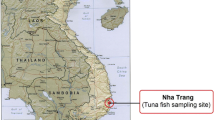Abstract
Twelve seaweed species were sampled from 1991 to 1993 in order to detect the impact of natural mineralization and mining in 14 contaminated and non-contaminated areas (between 24° and 30° S — more than 1200 km) along the northern Chilean coast. Instrumental neutron activation analysis (INAA) was used to measure the concentration of 17 chemical elements. The results showed high variability in and between species, among sampling sites and times of collection. The high values of heavy metals in seaweeds suggest that these marine organisms can be used as biological indicators for detecting mineralization and anthropogenic impact on coastal marine communities.
Similar content being viewed by others
References
Bowmer, K. H., 1986. Rapid biological assay and limitation in macrophyte ecotoxicology: a review. Aust. J. freshwat. Res. 37: 297–308.
Castagna, A., F. Sinatra, G. Castagna, A. Stoli & S. Zafarana, 1985. Trace elements evaluation in marine organisms. Mar. Pollut. Bull 16: 416–419.
Castilla, J. C. & E. Nealler, 1978. Marine environmental impact due to mining activities of El Salvador Copper Mine, Chile. Mar. Pollut. Bull. 14: 459–464.
Capuzzo, J. M., 1988. Physiological effects of a pollutant gradient: Introduction. Mar. Ecol. Prog. Ser. 64: 111.
Costantini, S., R. Giordano, L. Ciaralli & E. Beccaloni, 1991. Mercury, cadmium and lead evaluation in Posidonia oceanica and Codium tomentosum. Mar. Pollut. Bull. 22: 362–363.
Dauer, D. M., 1993. Biological criteria, environmental health and estuarine macrobenthic community structure. Mar. Pollut. Bull. 26: 249–257.
Förstner, U. & G. T. W. Wittmann, 1983. Metal Pollution in the Aquatic Environment. Spring-Verlag. Berlin, 486 pp.
Gray, J. S., 1992. Biological and ecological effects of marine pollutants and their detection. Mar. Pollut. Bull. 25: 48–50.
Grime, J. P., 1979. Evidence for the existence of three primary strategies in plants and its relevance to ecological and evolutionary theory. Am. Nat. 111: 1169–1194.
Guilizzoni, P., 1991. The role of heavy metals and toxic materials in the physiological ecology of submersed macrophytes. Aquat. Bot. 41: 87–109.
Ho, Y B., 1990. Ulva lactuca as bioindicator of metal contamination in intertidal waters in Hong Kong. Hydrobiologia 203: 73–81.
Hornung, H., D. Rabib & B. Krumgalz, 1981. The occurrence of mercury in marine algae and some gastropod molluscs of the Mediterranean shoreline of Israel. Mar. Pollut. Bull 12: 387–390.
Kureishy, T. W., 1991. Heavy metals in algae around the coast of Qatar. Mar. Pollut. Bull. 22: 414–416.
Lawrence, J. M., 1995. The use of life-history strategies in evaluating marine invertebrates for biotesting. Biologia Morya (Vladivostok).
Levine, H. G., 1984. The use of seaweeds for monitoring coastal waters. In L.E. Schubert (ed.), Algae as Ecological Indicators. Academic Press Inc. London: 189–209.
Maeda, S. & T. Sakaguchi, 1990. Accumulation and detoxification of toxic metal elements by algae. In I. Akatsuka (ed.), Introduction to Applied Phycology. SPB Academic Publishing by The Hague, The Netherlands: 109–136.
National Research Council, 1986. Ecological Knowledge and Environmental Problem-solving. Concepts and case of studies. National Academy Press, Washington, D.C.
Oyarzún, J., S. Collao & C. Ferraz, 1991. Distribución regional de Cd, Bi, Co, Ni y Mo en menas cupríferas chilenas entre los 22° y 33° S. Actas 6 Congreso Geológico Chileno 1: 714–718.
Phillips, D. J. H., 1977. The use of biological indicator organisms to monitor trace metal pollution in marine and estuarine environments: a review. Environ. Pollut. 13: 281–317.
Proser, F., 1983. Heavy metals in aquatic organisms. In U. Förstner & G.T.W. Wittmann (eds), Metal Pollution in the Aquatic Environment. Spring-Verlag, Berlin Heidelberg: 271–318.
Reisch, D. J., 1988. The use of toxicity testing in marine environmental resarch. In D. F. Soule, G. S. Kleppel (eds) Marine Organisms as Indicators. Spring-Verlag New York: 231–245.
Sillitoe, R. H., 1976. Andean mineralization: a model for the metallogeny of convergent plate margins. In D. F. Strong (ed.), Metallogeny and Plate Tectonics, Geol. Assoc. Can. Spec. Paper 14: 59–100.
Vermeer, K. & J. C. Castilla, 1991. High Cadmium residues observed during a pilot study in shorebird and their prey downstream from the El Salvador Copper Mine, Chile. Envir. Cont. Tox. 46: 242–248.
Vila, T. & R. H. Sillitoe, 1991. Gold-rich porphyry systems in the Maricunga belt, northern Chile. Econ. Geol. 86: 1238–1260.
Author information
Authors and Affiliations
Additional information
Facultad de Ciencias del Mar
Rights and permissions
About this article
Cite this article
Vasquez, J.A., Guerra, N. The use of seaweeds as bioindicators of natural and anthropogenic contaminants in northern Chile. Hydrobiologia 326, 327–333 (1996). https://doi.org/10.1007/BF00047826
Issue Date:
DOI: https://doi.org/10.1007/BF00047826




